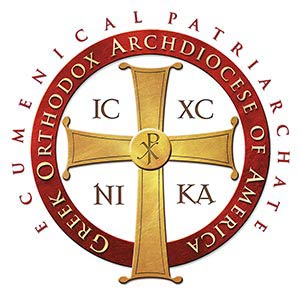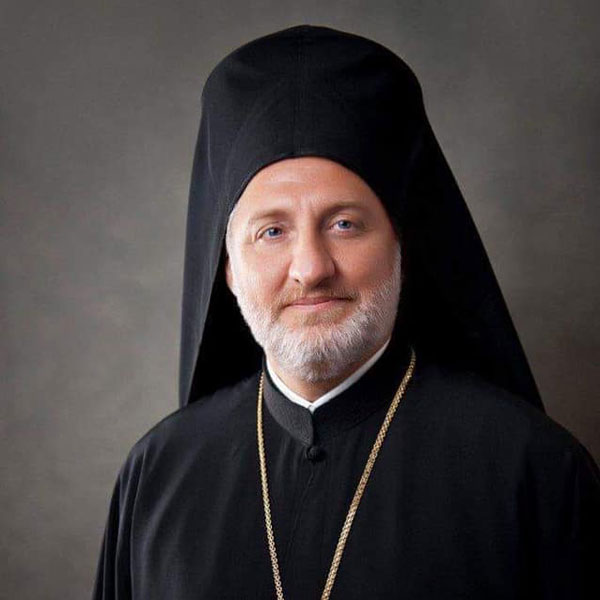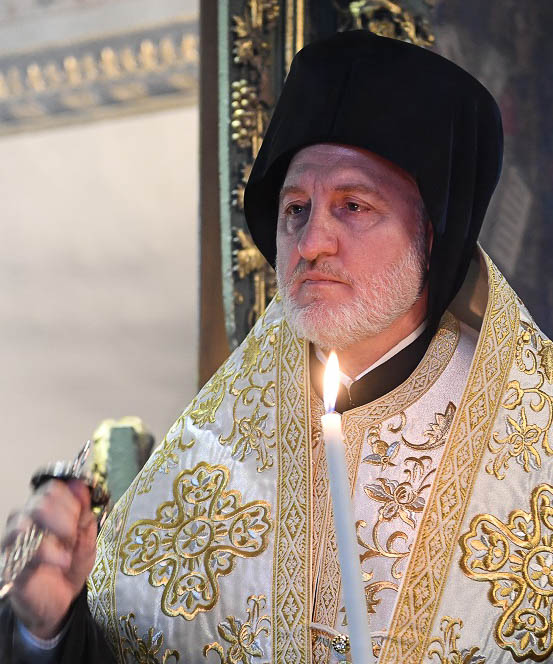Message from Metropolitan Alexios
My Beloved Ones,
Χριστὸς ἀνέστη!
Christ is Risen! Truly He is Risen!
As we continue through the beautiful Paschal period, this Sunday’s Gospel returns us to the public ministry of Jesus; He has not yet been crucified and not yet resurrected. In fact, the Evangelist John tells us that the subject of this week’s Gospel was one of the many instances which set the Pharisees and elders against Jesus; for He chose to perform this miracle on the Sabbath.
We read that Christ encounters a paralyzed man lying near the pool of Bethsaida, a pool which is occasionally visited by an angel, granting health to the first person who enters its waters. This man, whose condition had afflicted him for 38 years, is seen by Christ, lying on his bed. Christ naturally asks the man if he wishes to be made well. The man, not realizing who he is speaking to, answers that he would—only he has no way to enter the pool, and when he tries others enter the water before him.
Christ, however, is not simply content to offer this man assistance. He does not, for example, ask if the paralyzed man wishes to be brought into the pool; for surely this lonely individual could have been assisted by any number of the disciples who were with Jesus at that moment. Instead, Christ is speaking of a miracle greater than the passing blessing from one of God’s angels. For with seven simple words, “Rise, take up your bed and walk,” the man experiences the reality of coming face to face with God.
My brothers and sisters, much has been made of the physical reality of the miracle, but this story has a message for those who are able-bodied as well. Christ asks the paralytic, “Do you wish to be made well?” In this way, he speaks not simply to the person for whom the miracle is performed, but those who are paralyzed: paralyzed by grief; by fear; by loneliness; by sadness, or even indecision. The pools of Bethsaida are like the creations of men: however, blessed some of these technologies, therapies and pursuits may be (the passing of an angel to trouble our waters) they do not come from God alone. Only by entrusting our worries and cares to God, do we fully allow ourselves to be shaped and transformed through the peace which comes from knowing Him.
Another crucial aspect of this passage then is in the formulation of Christ’s words. He does not say, “You are healed!” When He says, “Rise, take up your bed and walk,” He does so, not only for the benefit of His disciples and the crowds that have gathered; He says this to demonstrate that after we have given our troubles and passions to God, we are called upon to carry on His work. We are meant to go forward and live our lives, as best as we are able; secure in our faith and belief in Jesus Christ.
+ALEXIOS
Metropolitan of Atlanta
Youth, Education & Hellenic Culture
St. Stephen’s Summer Camp 2019 Summer 2019 Dates are:
Week 1: June 23 -June 29
Week 2: June 30 - July 6
Week 3: July 7 - July 13
Week 4: July 14 - July 20
Week 5: July 21 - July 27
For more news, activities, and upcoming events, please click this link!
2019 OCAMPR Conference
"The Orthodox Christian Association of Medicine, Psychology and Religion, an international, pan-Orthodox organization endorsed by the Assembly of Canonical Orthodox Bishops of the United States of America, welcomes presentations of Workshops and Papers at its Annual Conference, " Isolation. Violence. Hope and Communion" which will be held November 7 -9 at Saints Peter and Paul Greek Orthodox Church in Glenview, IL (Chicago area).
The Annual Conference offers a unique opportunity for Orthodox clergy, theologians, and healthcare professionals to come together for fellowship and to engage in interdisciplinary dialogue. OCAMPR requests that proposals for presentations reflect professional, academic discussion on critical issues regarding the helping professions and pastoral care, specifically as it relates to our Orthodox Christian faith."
For more submission infornation please click here.
Family Life Ministry
A growing branch of Family Life Ministry and generously powered by Leadership 100, Engage Orthodoxy is a place for anyone to find Orthodox Christian Content curated by a thoughtful and intentional administrative team.
“Engage Orthodoxy” is not only the name of this new site, but it is also the name of a movement away from division and towards unity. Engage Orthodoxy is a movement towards community, involvement, Orthodox friendships, and relationships. EO seeks to bring the the faithful, the curious, the lost, and the searching TOWARDS their faith and Christ and in turn, towards each other. Engage Orthodoxy is a movement forward into the future of the faith. Join us as we move toward Christ, toward each other, and toward the church.
For more information, or to order “Woven: An Interactive Book for the Modern Teenage Girl on Orthodox Christianity” please visit, woveninhislove.org
We also share with you helpful links from the OCN and the Family Life Ministry of the Metropolis of Atlanta.
Journey of Marriage (Pre-Marital Seminar)
All couples marrying in the Metropolis must attend a Metropolis-sponsored Journey of Marriage seminar prior to their wedding. The couple will present their certificate of completion to their parish priest after the seminar.
- Sep 07, 2019 - St. George, Hollywood, FL
To see the full list of seminars in Florida and in our entire Metropolis please visit: http://www.familylifeministry.atlanta.goarch.org/upcoming-events-2/
Registration is online. Materials costs are included in the registration.
The Strategic Plan
Clergy-Laity Workshops (6/27 & 6/28/19)
Want to learn the latest best practices on how to grow your parish?
How about learning to create a plan for the future of your parish?
How do I fund the essential ministries of my parish and become less dependent on fund raisers?
Have I covered all the significant risks to my parish and what risks go beyond insurance coverage?
Are my religious education programs covering all that they should and are they effective? Is leadership training important to my role in the parish?
If you and your fellow parishioners have ever discussed these topics and you want to learn more, then …
PLAN TO PARTICIPATE AT THIS YEAR'S METROPOLIS CLERGY-LAITY ASSEMBLY, THURSDAY JUNE 27 and FRIDAY JUNE 28.
MORE DETAILS TO FOLLOW - Click here for the online portal.
Visit Click here to view a list of the completed goals.
Shop with Amazon, donate to the DRC
Amazon Smile is a program that allows for 0.5% of your eligible Amazon purchase to be donated to the Diakonia Retreat Center (No Added Cost To You). To find our Amazon Smile page, visit https://smile.amazon.com/ch/91-2187047.





 Today, May 16, 2019, His Eminence Archbishop Elpidophoros of America held a teleconference call with the Hierarchs and clergy – active and retired, of the Holy Archdiocese of America. The call was organized by Metropolitan Methodios of Boston in his capacity as Archiepiscopal Vicar, with the cooperation of the Archdiocesan Presbyters Council. Over 400 clergy participated in the call.
Today, May 16, 2019, His Eminence Archbishop Elpidophoros of America held a teleconference call with the Hierarchs and clergy – active and retired, of the Holy Archdiocese of America. The call was organized by Metropolitan Methodios of Boston in his capacity as Archiepiscopal Vicar, with the cooperation of the Archdiocesan Presbyters Council. Over 400 clergy participated in the call.
 Even though I am, as the Apostle Paul once said, “absent in the body” from you, I am very much with you in heart, in mind, and in spirit (cf. I Cor. 5:3). I wanted to take this moment to communicate with you through this marvelous tool of social media, to express how much I desire to embrace all of you as spiritual children, and to manifest to you the love with which God has graced my heart for the precious flock of the Holy Archdiocese of America.
Even though I am, as the Apostle Paul once said, “absent in the body” from you, I am very much with you in heart, in mind, and in spirit (cf. I Cor. 5:3). I wanted to take this moment to communicate with you through this marvelous tool of social media, to express how much I desire to embrace all of you as spiritual children, and to manifest to you the love with which God has graced my heart for the precious flock of the Holy Archdiocese of America.
 NEW YORK – Following the unanimous election of Metropolitan Elpidophoros of Bursa as Archbishop of America, His Eminence was presented with the Announcement of his election (Mikro Minima) and the Formal Election Announcement (Mega Minima) at the Sacred and Patriarchal Church of Saint George. After the ceremony he received the good wishes and blessings of His All-Holiness Ecumenical Patriarch Bartholomew and the Mother Church upon the assumption of his new duties.
NEW YORK – Following the unanimous election of Metropolitan Elpidophoros of Bursa as Archbishop of America, His Eminence was presented with the Announcement of his election (Mikro Minima) and the Formal Election Announcement (Mega Minima) at the Sacred and Patriarchal Church of Saint George. After the ceremony he received the good wishes and blessings of His All-Holiness Ecumenical Patriarch Bartholomew and the Mother Church upon the assumption of his new duties.
